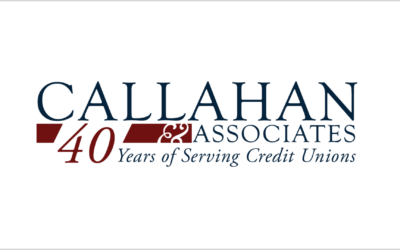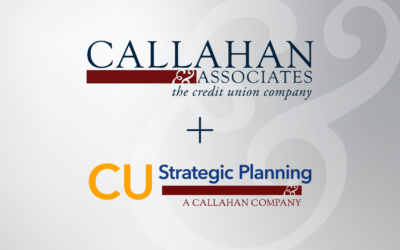Last week, Callahan & Associates hosted the inaugural installment in its “A Conversation With…” webinar series, featuring Great Lakes Credit Union CEO Steve Bugg. In the exclusive conversation, Bugg emphasized the value partnerships can bring to the industry and offered tips on how leaders can make the most of those opportunities. Want to learn more about these webinars? Let us know.
Great Lakes Credit Union ($1.3B, Bannockburn, IL) may be part of the billion-asset club, but the cooperative operates with a simple philosophy: We can’t do it all on our own.
That line of thinking has resulted in a strategy that prioritizes partnerships as a method of broadening the credit union’s economic and community impact.
Bugg joined Great Lakes five years ago after more than a decade on the management team at Indiana’s Heritage Federal Credit Union, and the directive from the Great Lakes board was to continue growing the credit union while expanding its community impact work. But like many credit unions, GLCU already volunteered and made financial donations to the community, along with providing innovative products and services.
“We looked at those as table stakes; they’re not innovative, they’re not unique,” says Bugg. “So how are we going to embark on really embracing our diversity in the communities that we serve [and] strategies that would really clearly set our credit union apart?”
The answer, Bugg continued, was a mix of aligning itself with like-minded organizations that could help the credit union expand its reach across the Chicago metro area, while also leaning into partnerships that could allow Great Lakes to think differently about new opportunities and grow its revenue base.
“One opportunity leads to another opportunity, which leads to another opportunity,” says Bugg. “We’re flush with all kinds of partnerships and ideas, and sometimes it’s a challenge to balance them all out.”
Bugg’s remarks came during the inaugural episode of “A Conversation With…”, a new webinar series from Callahan & Associates that offers an in-depth look at how credit union leaders are responding to challenges and opportunities across the industry.
Callahan subscribers can view a replay of the webinar at this link.
One of the biggest opportunities Great Lakes seized early in Bugg’s tenure was the chance to merge with Northside Credit Union, a $10 million-asset shop Bugg says many other institutions might have dismissed simply because its size and scale would have presented too much work with too little reward. However, the deal enabled Great Lakes to absorb Northside’s HUD counseling program, foundation, low-income designation, and more.
All of those have had an outsized impact on how Great Lakes operates. Not only did the LICU designation help with managing a commercial lending cap, but the HUD counseling program has enabled Bugg and his team to expand their reach in the community not just by serving their own members, but by providing financial counseling and education for customers of some large banks who then pay the credit union for its work in order to fulfill requirements under the Community Reinvestment Act.
“As we grow, we can become a better partner in the community,” says Bugg. He adds, “We’re continually improving what we inherited.”
One of its latest partnerships has involved The Leaders Network, a Chicago-area nonprofit focused on solutions for everything from food deserts to health care, lack of affordable financial services, and beyond. That work, says Bugg, wouldn’t have been possible without the Northside merger.
CUSO Strategy
Great Lakes’ emphasis on partnerships extended to credit union service organizations as well, and the cooperative has a simple set of questions it asks to determine how any potential CUSO partnership might help:
- Does it help gain experience, knowledge, or talent?
- Is there an opportunity to increase income (particularly non-interest income)?
- Is it simply an investment?
- Does it enhance services or products for members?
- Does it help gain efficiencies for employees faster than Great Lakes could on its own?
“We know we can’t do it all on our own, and there’s nothing wrong with partnering and looking at what those opportunities are,” says Bugg. “It’s that sharing, that networking. I’ve learned so much in my 16 years in the industry from other credit union leaders and staff I’ve met with, and I wouldn’t be where I am today without taking that information, processing it, and seeing how we can use that information to drive us forward.”
Asked what advice he had for other industry leaders on how to be a more effective partner, Bugg emphasized the need for a clearly defined strategy, along with a healthy dose of self-reflection.
“Have an honest conversation with yourself first and then with your leadership team and board on what you do really well,” he advises. “But what are some opportunities that if you partnered with others, you could do a much better job in partnering versus going alone? Sometimes we become so myopically focused – What’s in front of us? What’s the fire drill today? – and you’ve got to think beyond that.”
Interested in hearing from specific credit union leaders during a future episode of Callahan’s “A Conversation With…” webinar series? Email marketing@callahan.com and let us hear your suggestions!
More Blogs
Why “Jobs To Be Done” Should Be at the Core of Every Credit Union’s Strategy
Over the past decade, Callahan & Associates has worked closely with credit union leadership teams across the country to help them approach innovation and think more strategically about how they serve their members. A key part of this work has been rooted in...
Great Lakes Credit Union Featured In Callahan & Associates’ “Anatomy Of A Credit Union”
Washington, DC – Great Lakes Credit Union (GLCU) has been featured in the Spring 2025 edition of Callahan & Associates’ “Anatomy Of A Credit Union” series, which highlights exemplary credit unions demonstrating strategic innovation and community impact. The...
Callahan & Associates Celebrates 40 Years Of Credit Union Impact
Washington, DC – On April 1st, 2025, Callahan & Associates proudly marks its 40th anniversary, celebrating four decades of innovation, leadership, and commitment to serving the credit union industry. Since its founding in 1985, Callahan has been at the forefront...
Expertise Matters. Be The Partner Clients Trust.
For credit union suppliers to be considered indispensable, it’s more important than ever to know their clients' and prospects' businesses inside and out. Credit unions are looking for more than just basic products and services from their suppliers – they need...
Understanding Credit Union Financial Reports
The ability to understand a credit union’s financial performance is one of the most vital skills for industry suppliers and service organizations. Armed with this knowledge and having a basic understanding of a credit union’s financial reports can help sales and...
Navigating The NCUA’s 2024 Supervisory Priorities
In today's changing financial landscape, credit unions face a host of challenges when it comes to maintaining stability and ensuring member protection. Recently, the National Credit Union Administration (NCUA) outlined its supervisory priorities for 2024, highlighting...
Callahan & Associates and CU Strategic Planning Combine To Increase Credit Union Impact
Callahan & Associates and CU Strategic Planning proudly announce their strategic alliance, driven by a shared vision to empower credit unions to make a meaningful impact on their members and communities.
Insights And Advice For Credit Union Leaders
Are you new to a leadership role or preparing for one? Are you focused on empowering future leaders? Are you a veteran leader looking to be inspired? We recently asked new and established leaders what it means to embrace different leadership styles, encourage culture changes, and what advice they have for the next generation of leaders.
5 Governance Tips for Credit Union Boards
Insights From Callahan Consultant, Chris Howard There’s a growing — albeit misguided — distrust of credit unions today, making effective governance more important than ever … and harder than ever. At its core, good governance is fairly simple, although never...
15 Key Ratios Every Credit Union Board Should Know
There are thousands of data points you can share with your board about your credit union’s performance, the industry, and the economy. The challenge is identifying which key ratios are most important to your credit union. If you’re looking for a list of key ratios and...











